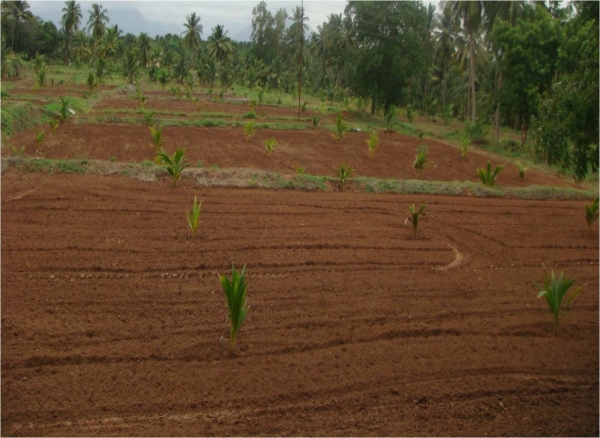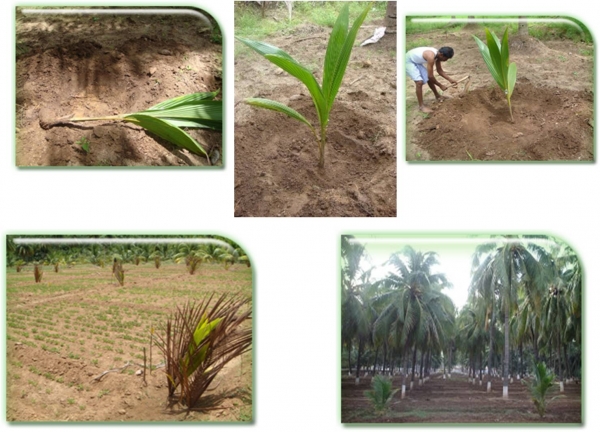Planting materials:
------------------
Selection of seed nuts and seedlings is of utmost importance in coconut as the performance of the new progeny can be evaluated only several years after planting. If the seed nuts and seedlings happen to be of poor quality, the new plantation will prove to be uneconomic, causing considerable loss of time and money to the grower. The fact that the coconut is a cross-fertilized palm and that it does not breed true, makes the selection of seed nuts and then of seedlings m the nursery all the more difficult and important. By means of a series of selections made at different stages, it is possible to eliminate poor quality seed nuts and seedlings.
Mother palm selection:
---------------------
• Regular bearer: A good regular bearing mother palm produces on an average one leaf and an inflorescence in its axil every month. So, there will be twelve bunches of varying stages of maturity at any one time with strong bunch stalks. Avoid trees producing habitually barren nuts.
• Straight stout trunk with even growth and closely spaced leaf scars.
• Spherical or semi spherical crown,
• High rate of leaf (more than 30 fully opened leaves) and spathe production (12 inflorescences)
• Short and stout petiole and wide leaf base firmly attached to the stem,
• Short and stout inflorescence stalk with bunches, preferably resting on the leaf petioles of the lower whorl and more number of female flowers (25 or more)
• The age of the palm chosen be middle age i.e., from 25 to 40 years. Even trees with 15 years age can be selected, if it is high yielding and has stabilized yield. (e.g., Chowghat dwarf). Avoid palms that are above 60 years.
• High yielding mother palms giving not less than 100 nuts/palm/annum under irrigated condition (70-80 nuts/annum under rain fed conditions) should be chosen for collecting seed nuts
• Husked nuts should weigh not less than 600 g.
• Mean copra content of 150 g per nut or more
• Free from pest and diseases.
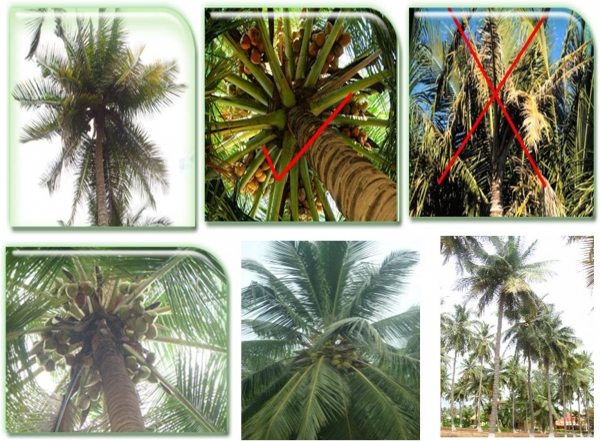
Avoid palms which have the following characteristics
• Palms have long, thin and pendulous inflorescence stalks
• Palms produce long, narrow, small sized or barren nuts
• Palms showing alternate bearing tendency also should be avoided.
• Palms show shedding of immature nuts in large numbers and
• Palms are grown under favourable environmental conditions. E.g. Trees near manure pits.
Collection of seed nuts
Generally the seed nuts are collected in the months of April-May and are planted in June in west coast region, whereas in the east coast region, nuts are sown in the months of October-November. Tall varieties are sown one or two months after collection whereas dwarfs should be sown immediately after harvest (within 10-15 days). Seed nuts grown in the pot mixture (soil: sand; FYM) filled in poly bag produce healthy and vigorous seedlings.
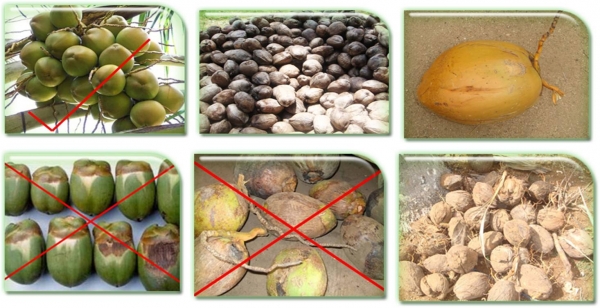
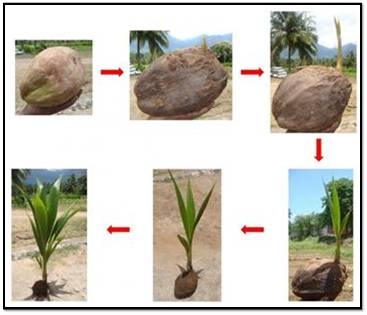
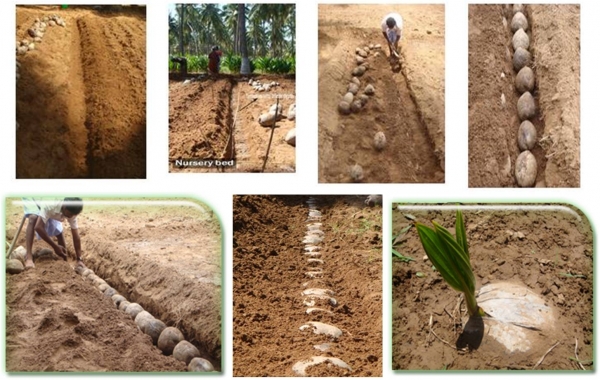
Selection of seedlings:
Only good quality seedlings are to be selected from the nursery for field planting. The vigorous, seedlings which are one year old, having minimum of six leaves and girth of 10 cm at the collar should be selected for planting. Early splitting of leaves is another character preferred for selecting good seedlings. Generally one-year-old seedlings are preferred for planting. However, for planting in waterlogged areas, ½ to 2 year old seedlings are preferred.
Poly bag nursery
Germinated seeds are transplanted in poly bags of size 60 x 40 cm with 8-10 holes at the bottom. The potting mixture is in the 2:1:1 ratio of topsoil, sand and FYM. The advantage of poly bag seedlings is that there is no transplanting shock and the seedlings are more vigorous. But the disadvantages include difficult for transportation and higher cost of seedling production.
Establishment of a plantation
Soil with a minimum depth of 1.2 metres and fairly good water holding capacity is preferred for coconut cultivation. Shallow soils with underlying hard rock, low lying areas subject to water stagnation and clayey soils are to be avoided as it will be difficult to raise successful coconut plantations under such conditions. However, in lands, reclaimed by heaping alternate layers of sand and clay, coconut thrives well. Proper supply of moisture either through well distributed rainfall or irrigation and sufficient drainage are essential for coconut.
Preparation of land and planting
Preparation of land tor planting coconut depends to a large extent on soil type and environmental factors. If the land is uneven and full of shrubs, the shrubs have to be cleared and land leveled before taking pits. The depth of pits will depend upon the type of soil. In laterite soil with rocky substratum, deeper and wider pus, 1.2 x 1.2 x 1.2 m, may be dug and filled up with loose soil, powdered cow dung and ash up to a depth of 60 cm before planting, loamy soils with low water table, planting in pit size of 1 x 1 x 1 m filled with top soil to height of 50 cm is generally recommended. However, when the water table is high, planting at the surface or even on mounds may be necessary Even while planting at the surface or mounds, digging pits and filling has to be done. While filling the pits with soil, it is advisable to use the top soil. Two layers of coconut husk can be arranged at the bottom of the pit before filling up the soil (with concave surface facing up). This will help in conserving the moisture. In laterite soil, addition of 2 kg of common salt will help in loosening the soil.
Spacing
For realizing better yield from coconut, optimum plant density must be maintained in the field. A spacing of 7.5 x 7.5 m is generally recommended for coconut. This will accommodate 177 palms per ha under the square system of planting. If the triangular system is adopted, an additional 20 to 25 palms can be planted. Also a hegde system can be adopted giving a spacing of 5.0 to 5.5 m along the rows and 9 to 10 m between rows. Wider spacing of 10 in x 10 m provides ample opportunity to accommodate a number of perennial and annual crops in the interspaces.
Time of planting
In well drained soils where water stagnation is not a problem, seedlings can be transplanted with the beginning of south-west monsoon. If irrigation facilities are available, it is advisable to take up planting at least a month before the monsoon sets in so that the seedlings get well established before the onset of heavy rains. Planting can also be taken up before the north¬-east monsoon. In low lying areas subject to inundation during monsoon periods, it is preferable to plant the seedlings after the cessation of the monsoon.
